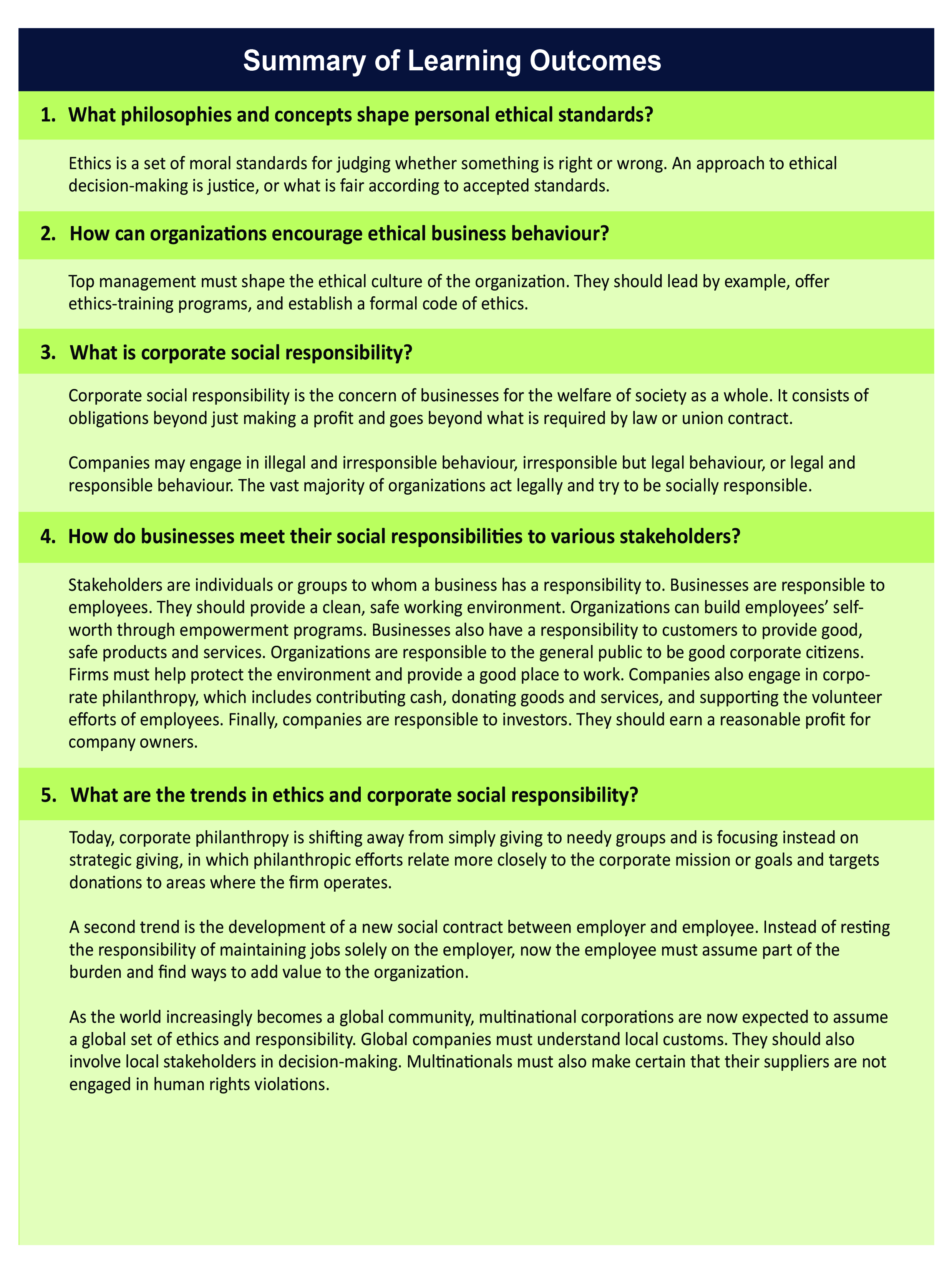Chapter 2: Ethical Decisions and Socially Responsible Business

Learning Objectives
After reading this chapter, you should be able to answer these questions:
- What philosophies and concepts shape personal ethical standards?
- How can organizations encourage ethical business behaviour?
- What is corporate social responsibility?
- How do businesses meet their social responsibilities to various stakeholders?
- What are the trends in ethics and corporate social responsibility?
2.1 Understanding Business Ethics
What philosophies and concepts shape personal ethical standards?
Every day, managers and business owners make business decisions based on what they believe to be right and wrong. Through their actions, they demonstrate to their employees what is and is not acceptable behaviour and shape the moral standard of the organization. As you will see in this chapter, personal and professional ethics are important cornerstones of an organization and shape its ultimate contributions to society in the form of corporate social responsibility. First, let’s consider how individual business ethics are formed.
Ethics is a set of moral standards for judging whether something is right or wrong. The first step in understanding business ethics is learning to recognize an ethical issue. An ethical issue is a situation where someone must choose between a set of actions that may be ethical or unethical. For example, Martin Shkreli, former CEO of Turing Pharmaceuticals, raised the price of a drug used for newborns and HIV patients by more than 5000 percent, defending the price increase as a “great business decision.”1 Few people would call that ethical behaviour. But consider the actions of the stranded, hungry people in New Orleans who lost everything in the aftermath of Hurricane Katrina. They broke into flooded stores, taking food and bottled water without paying for them. Was this unethical behaviour? Or what about the small Texas plastics manufacturer that employed over 100 people and specialized in the Latin American market? The president was distraught because he knew the firm would be bankrupt by the end of the year if it didn’t receive more contracts. He knew that he was losing business because he refused to pay bribes. Bribes were part of the culture in his major markets. Closing the firm would put many people out of work. Should he start paying bribes in order to stay in business? Would this be unethical? Let’s look at the next section to obtain some guidance on recognizing unethical situations.
Ethics business ethics and social responsibility video: https://youtu.be/0KhURlAim80
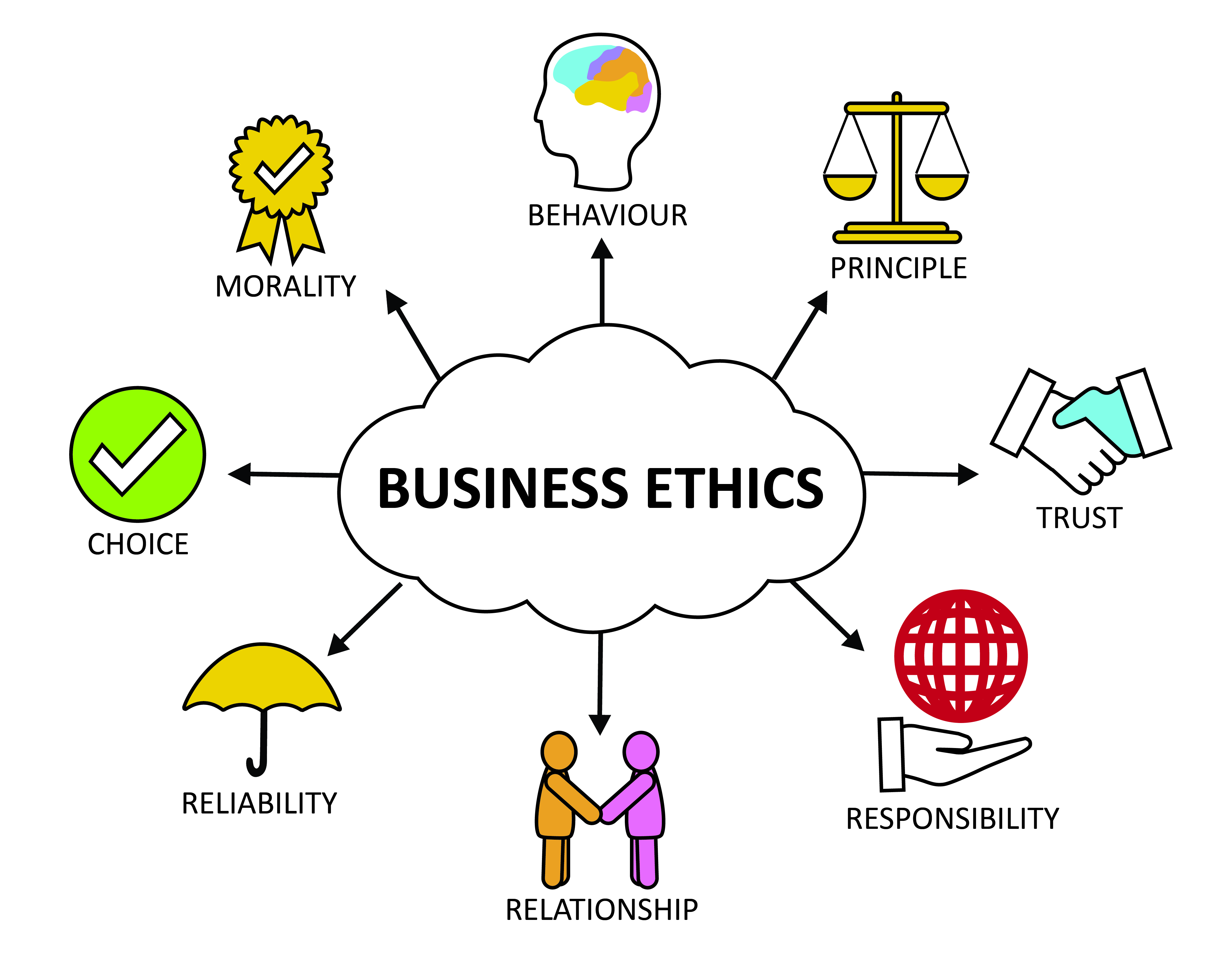 Recognizing Unethical Business Activities
Recognizing Unethical Business Activities
Researchers from Brigham Young University tell us that all unethical business activities will fall into one of the following categories:
- Taking things that don’t belong to you: The unauthorized use of someone else’s property or taking property under false pretenses is taking something that does not belong to you. Even the smallest offense, such as using the postage meter at your office for mailing personal letters or exaggerating your travel expenses, belongs in this category of ethical violations.
- Saying things you know are not true: Often, when trying for a promotion and advancement, fellow employees discredit their coworkers. Falsely assigning blame or inaccurately reporting conversations is lying. Although “This is the way the game is played around here” is a common justification, saying things that are untrue is an ethical violation.
- Giving or allowing false impressions: The salesperson who permits a potential customer to believe that cardboard boxes will hold the customer’s tomatoes for long-distance shipping when the salesperson knows the boxes are not strong enough has given a false impression. A car dealer who fails to disclose that a car has been in an accident is misleading potential customers.
- Buying influence or engaging in a conflict of interest: A conflict of interest occurs when the official responsibilities of an employee or government official are influenced by the potential for personal gain. Suppose a company awards a construction contract to a firm owned by the father of the provincial attorney general while the provincial attorney general’s office is investigating that company. If this construction award has the potential to shape the outcome of the investigation, a conflict of interest has occurred.
- Hiding or divulging information: Failing to disclose the results of medical studies that indicate your firm’s new drug has significant side effects is the ethical violation of hiding information about the potential harm your product has to purchasers. Taking your firm’s product development or trade secrets to a new place of employment constitutes the ethical violation of divulging proprietary information.
- Taking unfair advantage: Many current consumer protection laws were passed because so many businesses took unfair advantage of people who were not educated or were unable to discern the nuances of complex contracts. Credit disclosure requirements, truth-in-lending provisions, and new regulations on auto leasing all resulted because businesses misled consumers who could not easily follow the jargon of long, complex agreements.
- Committing improper personal behaviour: Although the ethical aspects of an employee’s right to privacy are still debated, it has become increasingly clear that personal conduct outside the job can influence performance and company reputation. Thus, a company driver must abstain from substance abuse because of safety issues. Even the traditional company holiday party and summer picnic have come under scrutiny due to the possibility that employees at and following these events might harm others through alcohol-related accidents.
- Abusing power and mistreating individuals: Suppose a manager sexually harasses an employee or subjects employees to humiliating corrections or reprimands in the presence of customers. In some cases, laws protect employees. Many situations, however, are simply interpersonal abuse that constitutes an ethical violation.
- Permitting organizational abuse: Many Canadian firms with operations overseas, such as Apple, Nike, and Levi Strauss, have faced issues of organizational abuse. The unfair treatment of workers in international operations appears in the form of child labour, demeaning wages, and excessive work hours. Although a business cannot change the culture of another country, it can perpetuate—or stop—abuse through its operations there.
- Violating rules: Many organizations use rules and processes to maintain internal control or respect the authority of managers. Although these rules may seem burdensome to employees trying to serve customers, a violation may be considered an unethical act.
- Condoning unethical actions: What if you witnessed a fellow employee embezzling company funds by forging her signature on a check? Would you report the violation? A winking tolerance of others’ unethical behaviour is itself unethical.2
After recognizing that a situation is unethical, the next question is what do you do? The action that a person takes is partially based upon his or her ethical philosophy. The environment in which we live and work also plays a role in our behaviour. This section describes personal philosophies and legal factors that influence the choices we make when confronting an ethical dilemma.
Justice—The Question of Fairness
Another factor influencing individual business ethics is justice, or what is fair according to prevailing standards of society. We all expect life to be reasonably fair. You expect your exams to be fair, the grading to be fair, and your wages to be fair based on the type of work being done.
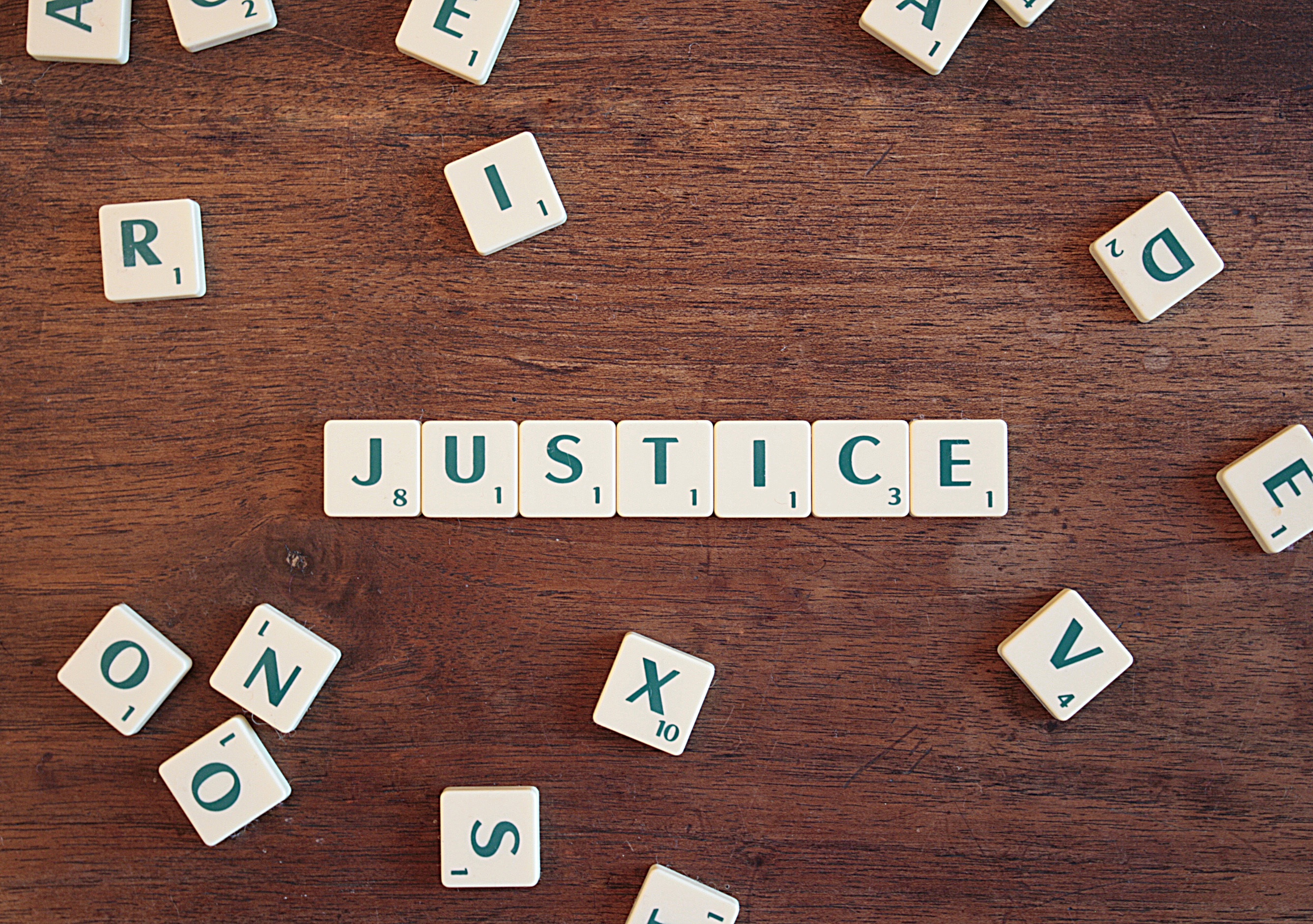
Today we take justice to mean an equitable distribution of the burdens and rewards that society has to offer. The distributive process varies from society to society. Those in a democratic society believe in the “equal pay for equal work” doctrine, in which individuals are rewarded based on the value the free market places on their services. Because the market places different values on different occupations, the rewards, such as wages, are not necessarily equal. Nevertheless, many regard the rewards as just. A politician who argued that a supermarket clerk should receive the same pay as a physician, for example, would not receive many votes from the Canadian people. At the other extreme, communist theorists have argued that justice would be served by a society in which burdens and rewards were distributed to individuals according to their abilities and their needs, respectively.
Individual Rights
In our society, individuals and groups have certain rights that exist under certain conditions regardless of any external circumstances. These rights serve as guides when making individual ethical decisions. The term human rights implies that certain rights—to life, to freedom, to the pursuit of happiness—are bestowed at birth and cannot be arbitrarily taken away. Denying the rights of an individual or group is considered to be unethical and illegal in most, though not all, parts of the world. Certain rights are guaranteed by the government and its laws, and these are considered legal rights.
2.2 How Organizations Influence Ethical Conduct
How can organizations encourage ethical business behaviour?
People choose between right and wrong based on their personal code of ethics. They are also influenced by the ethical environment created by their employers. Consider the following headlines:
- Investment advisor Bernard Madoff sentenced to 150 years in prison for swindling clients out of more than $65 billion.
- Former United Airlines CEO Jeff Smisek leaves the company after a federal investigation into whether United tried to influence officials at the Port Authority of New York.
- Renaud Laplanche, the founder of Lending Club, loses his job because of faulty practices and conflicts of interest at the online peer-to-peer lender.
- Wells Fargo CEO John Stumpf fired after company employees opened more than 2 million fake accounts to meet aggressive sales targets.3
As these actual stories illustrate, poor business ethics can create a very negative image for a company, can be expensive for the firm and/or the executives involved, and can result in bankruptcy and jail time for the offenders. Organizations can reduce the potential for these types of liability claims by leading through example, through various informal and formal programs, and by educating their employees about ethical standards.
Leading by Example
Employees often follow the examples set by their managers. Leaders and managers establish patterns of behaviour that determine what’s acceptable and what’s not within the organization. While Ben Cohen was president of Ben & Jerry’s ice cream, he followed a policy that no one could earn a salary more than seven times that of the lowest-paid worker. He wanted all employees to feel that they were equal. At the time he resigned, company sales were $140 million, and the lowest-paid worker earned $19,000 per year. Ben Cohen’s salary was $133,000, based on the “seven times” rule. A typical top executive of a $140 million company might have earned 10 times Cohen’s salary. Ben Cohen’s actions helped shape the ethical values of Ben & Jerry’s.
Offering Ethics Training Programs
In addition to providing a system to resolve ethical dilemmas, organizations also provide formal training to develop an awareness of questionable business activities and practice appropriate responses. Many companies have some type of ethics training program. The ones that are most effective, like those created by Levi Strauss, American Express, and Campbell Soup Company, begin with techniques for solving ethical dilemmas such as those discussed earlier. Next, employees are presented with a series of situations and asked to come up with the “best” ethical solution. According to a recent survey by the Ethics Resource Center, more than 80 percent of U.S. companies provide some sort of ethics training for employees, which may include online activities, videos, and even games.4
Establishing a Formal Code of Ethics
Most large companies and thousands of smaller ones have created, printed, and distributed codes of ethics. In general, a code of ethics provides employees with the knowledge of what their firm expects in terms of responsibilities and behaviour toward fellow employees, customers, and suppliers. Some ethical codes offer a lengthy and detailed set of guidelines for employees. Others are not really codes at all but rather summary statements of goals, policies, and priorities. Some companies have their codes framed and hung on office walls, included as a key component of employee handbooks, and/or posted on their corporate websites.
Examples of company codes of ethics:
- Costco: http://phx.corporate-ir.net/phoenix.zhtml?c=83830&p=irol-govhighlights
- Starbucks: https://www.starbucks.com/about-us/company-information/business-ethics-and-compliance
- AT&T: https://www.att.com/gen/investor-relations?pid=5595
Do codes of ethics make employees behave in a more ethical manner? Some people believe that they do. Others think that they are little more than public relations gimmicks. If senior management abides by the code of ethics and regularly emphasizes the code to employees, then it will likely have a positive influence on behaviour.
The “100 Best Corporate Citizens” as ranked by Corporate Responsibility magazine are selected based on seven categories, including employee relations, human rights, corporate governance (including code of ethics), philanthropy and community support, financial performance, environment, and climate change.5 The top corporate citizens in 2017 were:
- Hasbro, Inc.
- Intel Corp.
- Microsoft Corp.
- Altria Group, Inc.
- Campbell Soup Company
- Cisco Systems, Inc.
- Accenture
- Hormel Foods Corp.
- Lockheed Martin Corp.
- Ecolab, Inc.
Making the Right Decision
In many situations, there may be no simple right or wrong answers. Yet there are several questions you can ask yourself, and a couple of self-tests you can do, to help you make the right ethical decision. First, ask yourself, “Are there any legal restrictions or violations that will result from the action?” If so, take a different course of action. If not, ask yourself, “Does it violate my company’s code of ethics?” If so, again find a different path to follow. Third, ask, “Does this meet the guidelines of my own ethical philosophy?” If the answer is “yes,” then your decision must still pass two important tests.
The Feelings Test
You must now ask, “How does it make me feel?” This enables you to examine your comfort level with a particular decision. Many people find that, after reaching a decision on an issue, they still experience discomfort that may manifest itself in a loss of sleep or appetite. Those feelings of conscience can serve as a future guide in resolving ethical dilemmas.
The Newspaper or Social Media Test
The final test involves the front page of the newspaper or social media posts. The question to be asked is how an objective reporter would describe your decision in a front-page newspaper story, an online media site, or a social media platform such as Twitter or Facebook. Some managers rephrase the test for their employees: How will the headline read if I make this decision, or what will be the reaction of my social media followers? This test is helpful in spotting and resolving potential conflicts of interest.

2.3 Managing a Socially Responsible Business
What is corporate social responsibility?
Acting in an ethical manner is one of the four components of the pyramid of corporate social responsibility (CSR), which is the concern of businesses for the welfare of society as a whole. It consists of obligations beyond those required by law or union contract. This definition makes two important points. First, CSR is voluntary. Beneficial action required by law, such as cleaning up factories that are polluting air and water, is not voluntary. Second, the obligations of corporate social responsibility are broad. They extend beyond investors in the company to include workers, suppliers, consumers, communities, and society at large.
Exhibit 2.2 portrays economic responsibility as the foundation of the other three responsibilities. While a business pursues profits (economic responsibility), it is expected to obey the law (legal responsibility); to do what is right, just, and fair (ethical responsibility); and to be a good corporate citizen (philanthropic responsibility). These four components are distinct but together constitute the whole. Still, if the company doesn’t make a profit, then the other three responsibilities won’t matter.
Many companies continue to work hard to make the world a better place to live. Recent data suggests that Fortune 500 companies spend more than $15 billion annually on CSR activities. Consider the following examples:
- Starbucks has donated more than one million meals to local communities via its FoodShare program and alliance with Feeding America, giving 100 percent of leftover food from their seven thousand U.S. company-owned stores.
- Salesforce encourages its employees to volunteer in community activities and pays them for doing so, up to 56 paid hours every year. For employees who participate in seven days of volunteerism in one year, Salesforce also gives them a $1,000 grant to donate to the employee’s nonprofit of choice.
- Employees who work for Deloitte, a global audit, consulting, and financial services organization, can get paid for up to 48 hours of volunteer work each year. In a recent year, more than 27,000 Deloitte professionals contributed more than 353,000 volunteer hours to their communities around the world.6
Understanding Social Responsibility
Peter Drucker, the late globally respected management expert, said that we should look first at what an organization does to society and second at what it can do for society. This idea suggests that social responsibility has two basic dimensions: legality and responsibility.

Illegal and Irresponsible Behaviour
The idea of corporate social responsibility is so widespread today that it is hard to conceive of a company continually acting in illegal and irresponsible ways. Nevertheless, such actions do sometimes occur, which can create financial ruin for organizations, extreme financial hardships for many former employees, and general struggles for the communities in which they operate in. Unfortunately, top executives still walk away with millions. Some, however, will ultimately pay large fines and spend time in prison for their actions. Federal, provincial, and local laws determine whether an activity is legal or not. The laws that regulate business are discussed later in this module.
Irresponsible but Legal Behaviour
Sometimes companies act irresponsibly, yet their actions are legal. For example, the Minnesota-based company that makes MyPillow was recently fined $1 million by the state of California for making unsubstantiated claims that the “most comfortable pillow you’ll ever own” could help alleviate medical conditions such as snoring, fibromyalgia, migraines, and other disorders. The company’s CEO countered that the claims were actually made by customers; these testimonials were posted on the company’s website but later removed. In addition to the fine, the company faced several class-action lawsuits, and the Better Business Bureau has revoked MyPillow’s accreditation.7
Legal and Responsible Behaviour
The vast majority of business activities fall into the category of behaviour that is both legal and responsible. Most companies act legally, and most try to be socially responsible. Research shows that consumers, especially those under 30, are likely to buy brands that have excellent ethical track records and community involvement. Outdoor specialty retailer REI, for example, recently announced that it gave back nearly 70 percent of its profits to the outdoor community. A member cooperative, the company invested a record $9.3 million in its nonprofit partners in 2016.8
2.4 Responsibilities to Stakeholders
How do businesses meet their social responsibilities to various stakeholders?
What makes a company be admired or perceived as socially responsible? Such a company meets its obligations to its stakeholders. Stakeholders are the individuals or groups to whom a business has a responsibility to. The stakeholders of a business are its employees, its customers, the general public, and its investors.
Responsibility to Employees
An organization’s first responsibility is to provide a job to employees. Keeping people employed and letting them have time to enjoy the fruits of their labour is the finest thing business can do for society. Beyond this fundamental responsibility, employers must provide a clean, safe working environment that is free from all forms of discrimination. Companies should also strive to provide job security whenever possible.
Enlightened firms also empower employees to make decisions on their own and suggest solutions to company problems. Empowerment contributes to an employee’s self-worth, which, in turn, increases productivity and reduces absenteeism.
Each year, in collaboration with Great Place to Work®, Fortune conducts an extensive employee survey of the best places to work in the United States. For 2017, the top companies included Google, Wegmans Food Markets, Edward Jones, Genentech, Salesforce, Acuity, and Quicken Loans. Some companies offer unusual benefits to their employees. For example, biotech company Genentech offers employee compensation for taking alternative methods of transportation to work at its South San Francisco campus. Employees can earn $12 per day for walking or biking to work, and those who drive a carpool or vanpool can earn $8 and $16, respectively. In addition, the company offers free commuter bus service for all employees via 27 routes around the Bay Area.9
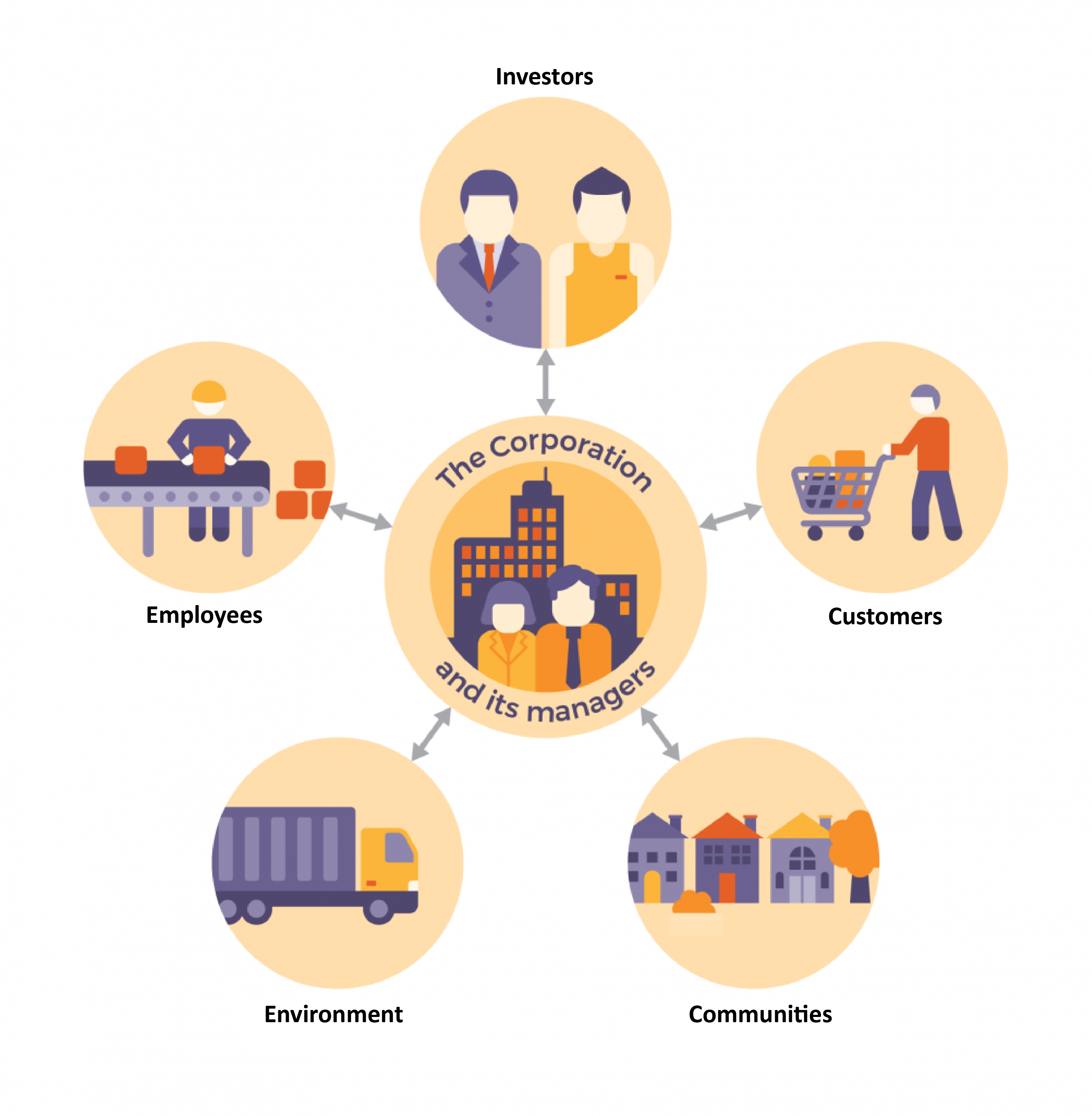
Responsibility to Customers
To be successful in today’s business environment, a company must satisfy its customers. A firm must deliver what it promises, as well as be honest and forthright in everyday interactions with customers, suppliers, and others. Recent research suggests that many consumers, particularly millennials, prefer to do business with companies and brands that communicate socially responsible messages, utilize sustainable manufacturing processes, and practice ethical business standards.10
Responsibility to Society
A business must also be responsible to society. A business provides a community with jobs, goods, and services. It also pays taxes that support schools, hospitals, and better roads. Some companies have taken an additional step to demonstrate their commitment to stakeholders and society as a whole by becoming Certified Benefit Corporations, or B Corps for short. Verified by B Lab, a global nonprofit organization, B Corps meet the highest standards of social and environmental performance, public transparency, legal accountability, and strive to use the power of business to solve social and environmental problems via an impact assessment that rates each company on a possible score of 200 points. To become certified as a Benefit Corporation, companies need to reach a score of at least 80 and must be recertified every two years. There are more than 2,000 companies worldwide that have been certified as B Corps, including Method, W.S. Badger Company, Fishpeople Seafood, LEAP Organics, New Belgium Brewing Company, Ben & Jerry’s, Cabot Creamery Co-op, Comet Skateboards, Etsy, Patagonia, Plum Organics, and Warby Parker.11
Environmental Protection
Business is also responsible for protecting and improving the world’s fragile environment. The world’s forests are being destroyed fast. Every second, an area the size of a football field is laid bare. Plant and animal species are becoming extinct at the rate of 17 species per hour. A continent-size hole is opening up in the earth’s protective ozone shield. Each year we throw out 80 percent more refuse than we did in 1960; as a result, more than half of the nation’s landfills are filled to capacity.
To slow the erosion of the world’s natural resources, many companies have become more environmentally responsible. For example, Toyota now uses renewable energy sources such as solar, wind, geothermal, and water power for electricity to run its facilities. When its new $1 billion North American headquarters opened in Plano, Texas, in May 2017, Toyota said the 2.1 million square-foot campus would eventually be powered by 100% clean energy, helping the auto giant move closer to its goal of eliminating carbon emissions in all of its operations.12
Corporate Philanthropy
Companies also display their social responsibility through corporate philanthropy. Corporate philanthropy includes cash contributions, donations of equipment and products, and support for the volunteer efforts of company employees. American Express is a major supporter of the Red Cross. The organization relies almost entirely on charitable gifts to carry out its programs and services, which include disaster relief, armed-forces emergency relief, blood and tissue services, and health and safety services. The funds provided by American Express have enabled the Red Cross to deliver humanitarian relief to victims of numerous disasters around the world.13 When Hurricane Katrina hit the Gulf Coast, Bayer sent 45,000 diabetes blood glucose monitors to the relief effort. Within weeks of the disaster, Abbott, Alcoa, Dell, Disney, Intel, UPS, Walgreens, Walmart, and others contributed more than $550 million for disaster relief.14

Responsibilities to Investors
Companies’ relationships with investors also entail social responsibility. Although a company’s economic responsibility to make a profit might seem to be its main obligation to shareholders, some investors are increasingly emphasizing other aspects of social responsibility.
Some investors are limiting their investments to securities (e.g., stocks and bonds) that coincide with their beliefs on ethical and social responsibility. This is called social investing. For example, a social investment fund might eliminate from consideration the securities of all companies that make tobacco products, liquor, weapons, or have a history of being environmentally irresponsible. Not all social investment strategies are alike. Some ethical mutual funds will not invest in government securities because they help to fund the military; others freely buy government securities, with managers noting that federal funds also support the arts and pay for AIDS research. Today, assets invested using socially responsible strategies total more than $7 trillion.15
Perhaps partly due to the global recession of 2007–2009, over the last several years, companies have tried to meet their responsibilities to investors as well as to their other stakeholders. Recent research suggests that now more than ever, CEOs are being held to higher standards by boards of directors, investors, governments, media, and even employees when it comes to corporate accountability and ethical behaviour. A recent global study by PwC reveals that over the last several years, there has been a large increase in the number of CEOs being forced out due to some sort of ethical lapse in their organizations. Strategies to prevent such missteps should include establishing a culture of integrity to prevent anyone from breaking the rules, making sure company goals and metrics do not create undue pressure on employees to cut corners, and implementing effective processes and controls to minimize the opportunity for unethical behaviour.16
2.5 Trends in Ethics and Corporate Social Responsibility
What are the trends in ethics and corporate social responsibility?
Three important trends related to ethics and corporate social responsibility are strategic changes in corporate philanthropy, a new social contract between employers and employees, and the growth of global ethics and corporate social responsibility.
Changes in Corporate Philanthropy
Historically, corporate philanthropy has typically involved companies seeking out charitable groups and giving them money or donating company products or services. Today, the focus has shifted to strategic giving, which ties philanthropy and corporate social responsibility efforts closely to a company’s mission or goals and targets donations to the communities where a company does business. Some of the top businesses recognized for their efforts in giving back to the communities in which they operate include technology giant Salesforce, NuStar Energy, insurance and financial services firm Veterans United, and software leader Intuit.17
Cause related marketing video: https://youtu.be/C1s65IGuRMM
A Social Contract between Employer and Employee
Another trend in social responsibility is the effort by organizations to redefine their relationship with their employees. Many people have viewed social responsibility as a one-way street that focuses on the obligations of business to society, employees, and others. Now, companies recognize that the social contract between employer and employee is an important aspect of the workplace and that both groups have to be committed to working together in order for the organization to prosper. The social contract can be defined in terms of four important aspects: compensation, management, culture, and learning and development.18
When it comes to compensation, companies today must recognize that most employees do not stay with one organization for decades. Thus, companies need to change their compensation structure to acknowledge the importance of short-term performance and to update their methods for determining compensation, including benefits and other nontraditional perks such as paid leave and telecommuting options.
In the current workplace environment, where employees are likely to jump to new jobs every couple years, managers need to take a more active and engaged approach to supervising employees and perhaps change the way they think about loyalty, which may be difficult for managers who are used to supervising the same group of employees for a long period of time. Engaging employees on a regular basis, setting realistic expectations, and identifying specific development paths may help retain key employees.
Thanks to today’s tight labour market, some employees feel empowered to demand more from their employer and its overall culture via strategies such as increased flexibility, transparency, and fairness. This increased importance of the employee’s role in the company’s culture helps workers stay engaged in the mission of the organization and perhaps makes them less likely to look elsewhere for employment.
Finally, rapidly changing technology used in today’s workplace continues to shift the learning and development of the employer-employee contract, causing immense challenges to both companies and workers. It may be more difficult to identify the employee skills that will be critical over the next several years, causing employers either to increase training of current workers or to look outside the organization for other individuals who already possess the technical skills needed to get the job done.
Global Ethics and Social Responsibility
When Canadian businesses expand into global markets, they must take their codes of ethics and policies on corporate social responsibility with them. As a citizen of several countries, a multinational corporation has several responsibilities. These include respecting local practices and customs, ensuring that there is harmony between the organization’s staff and the host population, providing management leadership, and developing a solid group of local managers who will be a credit to their community. When a multinational firm makes an investment in a foreign country, it should commit to a long-term relationship. That means involving all stakeholders in the host country in decision-making. Finally, a responsible multinational will implement ethical guidelines within the organization in the host country. By fulfilling these responsibilities, the company will foster respect for both local and international laws.
Multinational corporations often must balance conflicting interests of stakeholders when making decisions regarding social responsibilities, especially in the area of human rights. Questions involving child labour, forced labor, minimum wages, and workplace safety can be particularly difficult. Recently Gap, Inc. decided to publish the list of its global factories in an effort to provide transparency about its suppliers and the efforts the company continues to make to improve working conditions around the world. The company has partnered with Verité, a nongovernmental organization focused on ensuring that people work under safe, fair, and legal conditions. By soliciting feedback from factory workers who make its products, Gap is hoping to improve working conditions and help these factories become leaders in their local communities.19
Sustainability
Sustainability has become such an important concept that it is frequently used interchangeably with CSR. Indeed, for some companies it seems that CSR is sustainability. This is perhaps not surprising, given the growing media attention on issues related to sustainability.
Sustainability is a concept derived from environmentalism; it originally referred to the ability of a society or company to continue to operate without compromising the planet’s environmental condition in the future. In other words, a sustainable corporation is one that can sustain its current activities without adding to the world’s environmental problems. Sustainability is therefore a very challenging goal, and many environmentalists maintain that no corporation today operates sustainably, since all use energy (leading to the gradual depletion of fossil fuels while emitting greenhouse gases) and all produce waste products like garbage and industrial chemicals. Whether or not true sustainability will be attainable in the near future, the development and promotion of sustainability strategies has become an obsession for most large corporations today, as demonstrated by their websites’ inevitable reference to the corporation’s sincere commitment to sustainability and responsible environmental practices. No corporation or corporate executive today will be caught saying they do not really care about the environment. However, if we observe their actions rather than their words, we may have cause for doubt.
Corporate social responsibility and sustainability video: https://youtu.be/xoE8XlcDUI8

Whistleblowing
A whistleblower is a person who exposes any kind of information that reveals illegal, unethical, or not correct activities within an organization that is either private or public. Many whistleblowers have stated that they were motivated to take action and put an end to unethical practices after witnessing injustices in their businesses or organizations. In addition to ethics, social and organizational pressures are also motivating forces. A 2012 study found that individuals are more likely to blow the whistle when several others know about the wrongdoing, because they would otherwise fear consequences for keeping silent.
The motivation for whistleblowing isn’t always virtuous, and the outcome isn’t always positive either. There are cases involving employees who blew the whistle as an act of revenge against their employer or supervisor, for instance. While it’s possible for the whistleblower to be viewed as a “hero” for his/her courage and truth telling, it’s also possible to be seen as a traitor or tattletale—as just one of the many disgruntled employees who are simply trying to get even for a perceived but imaginary injustice. One of the barriers to whistleblowing is the belief—widespread in the professional world—that individuals are bound to secrecy within their work sector. Accordingly, whistleblowing becomes a moral choice that pits the employee’s loyalty to an employer against the employee’s responsibility to serve the public interest. As a result, in Canada, whistleblower protection laws and regulations have been enacted to guarantee freedom of speech for workers and contractors in certain situations. Whistleblowers have the right to file complaints that they believe give reasonable evidence of a violation of a law, rule, or regulation; gross mismanagement; gross waste of funds; an abuse of authority; or a substantial and specific danger to public health or safety.
Key Terms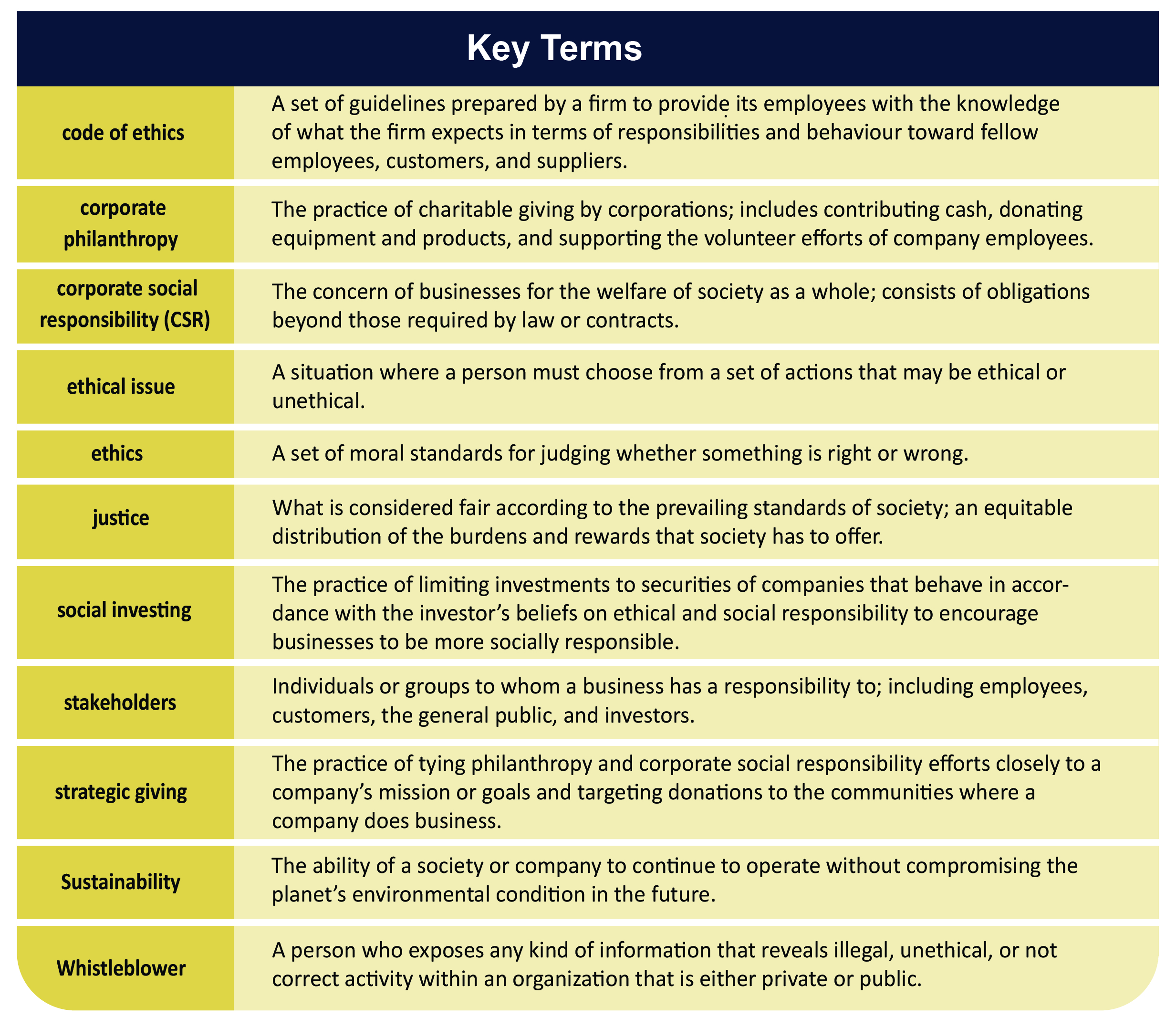
Summary of Learning Outcomes